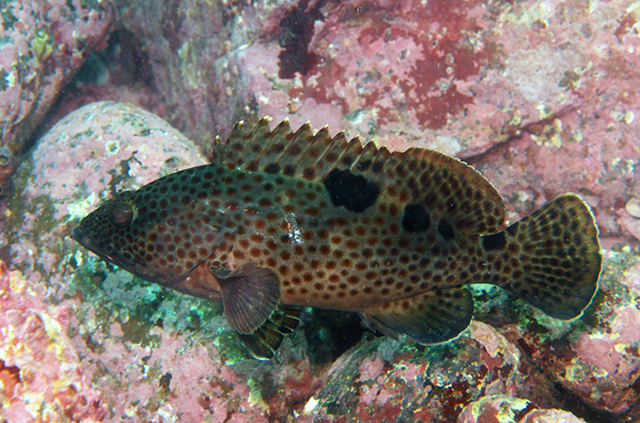| Epinephelidae (Groupers) |
| 50 cm TL (male/unsexed) |
|
reef-associated; marine; depth range 0 - 30 m |
| Northwest Pacific: southern Japan, Korea, Taiwan, and China. Reports of the species (under the valid name or as Epinephelus fario) from the Indian Ocean are apparently based on misidentifications. |
|
Dorsal spines (total): 11-11; Dorsal soft rays (total): 16-17; Anal spines: 3-3; Anal soft rays: 8-8. Preopercle rounded; serrae mostly hidden by skin; upper edge of operculum straight; nostrils small, subequal; maxilla reaches to or beyond vertical at rear edge of the eye. Area behind pectoral-fin tip with a patch of ctenoid scales in juveniles. Color is pale brown with small red or reddish brown spots. Fins darker, also covered with spots and often with a narrow white edge. A black blotch is at the base of the last 3 dorsal-fin spines, a smaller blotch at the base of the middle dorsal-fin rays, and a third on top of the caudal peduncle. Distinguished further by the following characteristics: body depth contained 2.7-3.3 times in SL; head length 2.4-2.6 times in SL; slightly convex interorbital area; small anterior and posterior nostrils, subequal; maxilla reaches to or past vertical at rear edge of eye; 2 rows of teeth on midlateral part of lower jaw (Ref. 89707). |
| Juveniles are common in tide pools and in shallow clear water around rocks and coral reefs; adults found in deeper water. Kuo et al. (1988, Ref. 6826) induced sex reversal and artificial spawning (referred to as 'Epinephelus fario'). |
|
Least Concern (LC); Date assessed: 25 November 2016 Ref. (130435)
|
| harmless |
|
As noted by Randall and Heemstra (1991), some recent authors have used the name E. fario (Thunberg) for E. trimaculatus. As pointed out by Bauchot et al. (1984), E. fario is unidentifiable (Ref. 26066). |
Source and more info: www.fishbase.org. For personal, classroom, and other internal use only. Not for publication.

